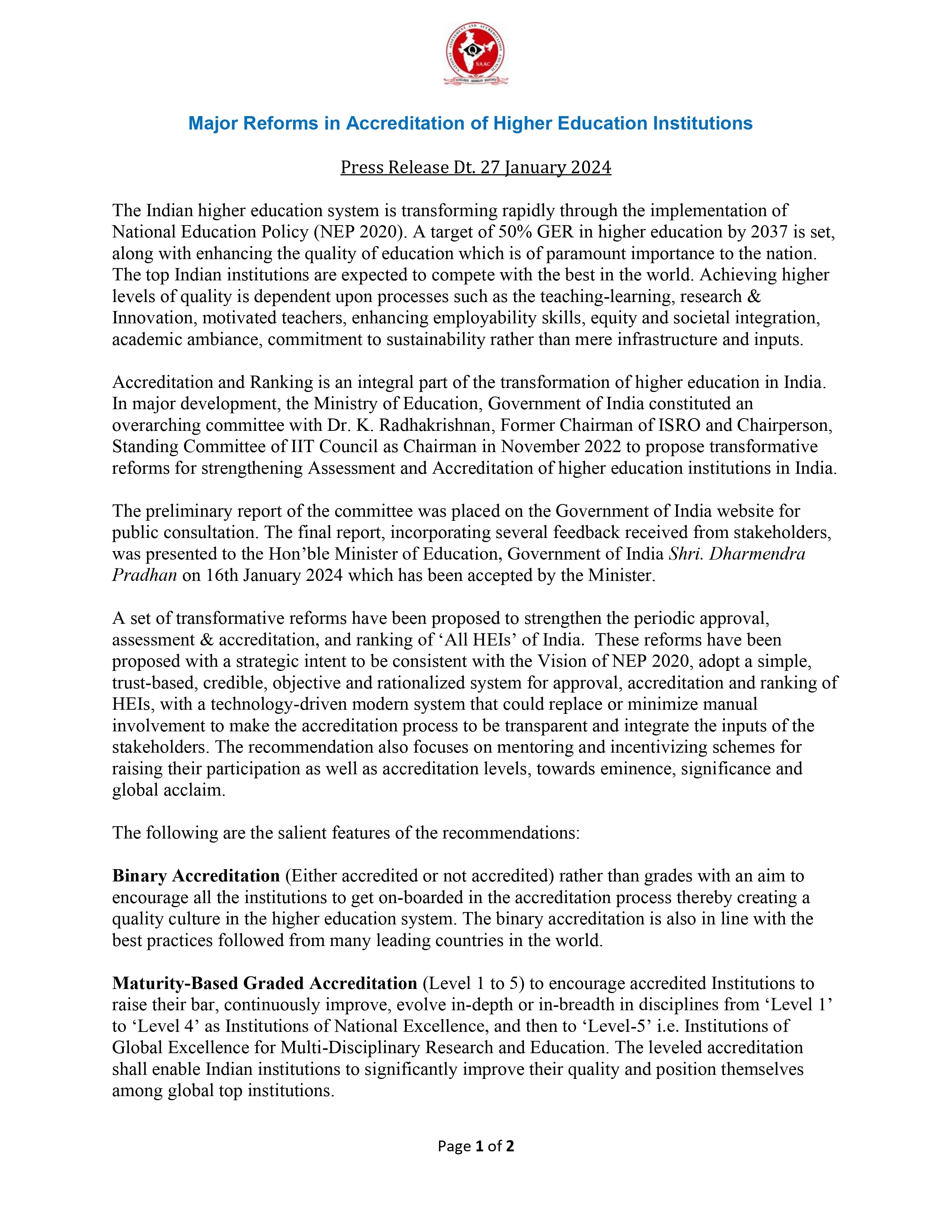
By clicking “Accept All Cookies”, you agree to the storing of cookies on your device to enhance site navigation, analyze site usage, and assist in our marketing efforts Cookies Policy.

New Delhi: Higher Education Institutions (HEIs) in the country will no longer be given grades under the accreditation system, rather they will be categorised either as “accredited” or “not accredited”, the National Assessment and Accreditation Council (NAAC) decided on Saturday, news agency PTI reported. In an executive council meeting held on January 27(Saturday), the National Assessment and Accreditation Council decided that the accredited institutions will be further given levels between one and five to encourage them to achieve the highest level.
The National Assessment and Accreditation Council (NAAC) is an autonomous body under the UGC that assesses and certifies higher educational institutions with gradings as part of accreditation. The NAAC conducts the Assessment and Accreditation exercise utilising the expertise of a large number of academics from universities, colleges, research and development organisations and government entities across the country as part of Peer Review Teams. NAAC evaluates the institutions for its conformance to the standards of quality in terms of its performance related to the educational processes and outcomes, curriculum coverage, teaching-learning processes, faculty, research, infrastructure, learning resources, organisation, governance, financial well being and student services.
As per the PTI report, these sets of reforms will be implemented in two stages — the binary accreditation (accredited or not accredited) system in the next four months, and Maturity-Based Graded Accreditation (level 1 to 5) by December. “There will be Binary Accreditation (either accredited or not accredited) rather than grades with an aim to encourage all the institutions to get on-boarded in the accreditation process thereby creating a quality culture in the higher education system,” a senior Ministry of Education (MoE) official said, PTI reported. “The binary accreditation is also in line with the best practices followed in many leading countries in the world,” he added.
Moreover, the accreditation authority will use the Maturity-Based Graded Accreditation (Level 1 to 5) to encourage accredited institutions to raise their bar to achieve the highest level of 5 which is “Institutions of Global Excellence for Multi-Disciplinary Research and Education”. The level-grading system shall enable Indian institutions to significantly improve their quality and position themselves among the global best, the official said, PTI reported.


As per the current system, a significant outcome of the assessment is the final grading of the institutions. After assessment, the Cumulative Grade Point Average (CGPA) of an institution is computed for those institutions which clear the grade qualifiers. Based on the CGPA obtained by the institution in maximum possible score of 4.00, the final grade is assigned on a seven-point scale. The seven-point scale refers to the seven letter grades each aligned to the seven specific score-range.
The official also said that an expert committee set up by the ministry has suggested a set of transformative reforms to strengthen the periodic approval, assessment and accreditation, and ranking of HEIs. The National Education Policy (NEP) 2020 set a target of 50 per cent Gross Enrolment Ratio by 2035, for which the MoE constituted a committee headed by K Radhakrishnan, former chairman of ISRO in November 2022.
The committee, following consultation with the public, presented its final report to union education minister Dharmendra Pradhan on January 16. “The committee recommended a set of transformative reforms to strengthen the periodic approval, assessment and accreditation, and ranking of Indian HEIs. The recommendation also focuses on mentoring and incentivizing schemes for raising their participation as well as accreditation levels,” the official said, PTI added. According to its recommendations, the metrics for Binary and Maturity-Based Graded Accreditation focusses on processes, outcomes and impact across different attributes of HEIs (instead of mere input-centric). “The new process shall consider the heterogeneity of HEIs in the country, categorise them based on their orientation/vision and heritage/legacy, and then seek information from the HEIs that are appropriate for their category rather than a one-size-fits-all model. There will be a special focus on rural and remote location institutions through mentoring and handholding,” the official said.
A new “One Nation One Data Platform” has also been proposed to ensure integrity and transparency in handling institutional data collected for varied purposes like approval, accreditation, and ranking, with an in-built design for collateral cross-checking of the authenticity of data. To enhance the validity and reliability of the data “stakeholder validation” has been proposed to integrate stakeholders as part of the accreditation and ranking process.
(With Inputs From PTI)
For breaking news and live news updates, like us on Facebook or follow us on Twitter and Instagram. Read more on Latest Exams & Results News on India.com.